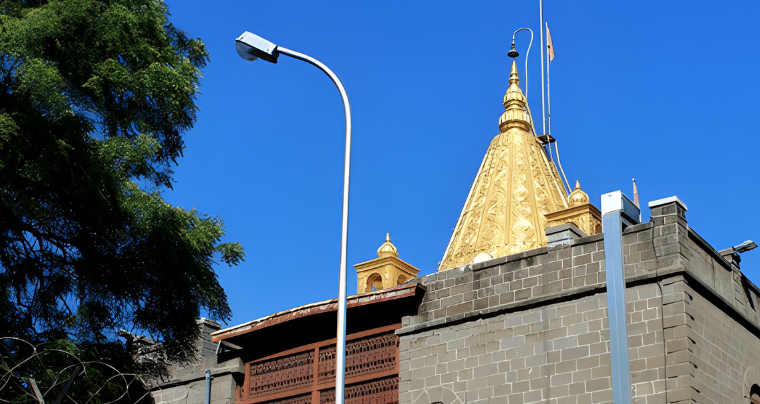Shirdi Sai Baba Temple
With millions of followers from all over the world, the Shirdi Sai Baba Temple is one of India’s most cherished pilgrimage attractions. Sai Baba, a spiritual saint renowned for his teachings on compassion, love, and faith, is the subject of this shrine in Shirdi, Maharashtra. One of the most well-known temples in Maharashtra, it is a hub of devotion, mysticism, and miracles. Sai Baba was a spiritual leader and mystical saint who advocated for selfless service, devotion to God, and worldwide brotherhood. When he was at Shirdi, the little village became a significant centre of spiritual activity. His devotees continue to go to Shirdi in search of spiritual enlightenment and heavenly benefits, regardless of their caste, religion, or faith. Shirdi’s Sai Baba Temple welcomes people from all walks of life and serves as a symbol of peace and harmony in addition to being a site of devotion.
Thank you for reading this post, don't forget to subscribe!The Shirdi Sai Baba Temple’s History
1. The Arrival of Sai Baba at Shirdi
- The life and teachings of Sai Baba are intricately linked to the history of the Sai Baba Temple.
- In the middle of the 19th century, Sai Baba came to Shirdi as a young ascetic living beneath a neem tree while wearing a modest robe.
- Since he never revealed his true name, caste, or religious background, his origin is still unknown. Despite this, the people were drawn to him by his spirituality and wisdom, and they finally accepted him as a saint.
- Sai Baba’s teachings placed a strong emphasis on religious unity, dedication, almsgiving, and human service.
- He frequently taught his followers spiritual teachings through prayers, parables, and altruistic deeds.
- He spent more than 60 years at Shirdi, where he cured the sick, worked several miracles, and brought innumerable disciples to a life of devotion and morality.
2. Establishment of the Sai Baba Temple
- Sai Baba spent most of his life in Dwarkamai Masjid, where his mortal remains were buried following his Mahasamadhi (passing) on October 15, 1918.
- His followers and admirers decided to erect a magnificent temple in his honour shortly after.
- A rich devotee named Shreemant Gopalrao Booty first built the Samadhi Mandir, which now contains Sai Baba’s tomb, as a place for Sai Baba to rest while he was alive. But it was transformed into Sai Baba’s tomb after his death, and it became the main house of devotion.
3. Development and Growth of the Temple
- The Shirdi Sai Baba Temple expanded in size and renown throughout the years. Thousands of devotees attended the temple daily by the middle of the 20th century, leading to the Shri Sai Baba Sansthan Trust taking control of its upkeep and growth. To improve the spiritual experience for guests, several amenities were added, such as pilgrims’ lodging, a sizable prayer hall, and community service programs.
- With over 50,000 worshipers every day and millions during festivals like Sai Baba’s Punyatithi and Ram Navami, the temple is becoming one of Maharashtra’s most popular spiritual destinations.
- Sai Baba’s heavenly presence and the temple’s rich history make it an everlasting beacon of faith that continues to inspire and guide people.
The Significance of Shirdi Sai Baba Temple
With millions of followers worldwide, the Shirdi Sai Baba Temple is one of India’s most famous pilgrimage attractions. It emphasizes faith, dedication, and service to mankind, and its relevance transcends theological bounds. Sai Baba of Shirdi, a spiritual saint who advocated for compassion, unity, and the idea that all people are brothers, is honoured in the temple.
1. Religious Harmony & Universal Appeal
- The temple is a hallowed place for people of all religions because of Sai Baba’s teachings, which cut beyond religious and cultural boundaries.
- All religions lead to the same divine truth, according to his “Sabka Malik Ek” (God is One) doctrine.
- Shirdi is visited by Christians, Muslims, Hindus, and others from a wide range of backgrounds, proving that Sai Baba’s teachings are inclusive.
2. Divine Presence & Miracles
- Through trust and dedication, Sai Baba’s followers continue to witness his astounding gifts.
- Healing the Sick: Many people think that Sai Baba’s blessings and Udi (holy ash) might heal illnesses and maladies.
- Divine Guidance: Sai Baba frequently showed up in dreams to provide followers with direction and answers to their issues.
- Protection & Blessings: Several stories of Sai Baba shielding followers from perils and adversity are shared by devotees.
3. Life Lessons & Spiritual Teachings
- Confidence (Shraddha) and patience (Saburi) are central to Sai Baba’s teachings, which exhort people to have confidence in God’s time.
- He urged people to aid the poor without distinction and advocated for unselfish service, love, and generosity.
- Acts of kindness are encouraged by Sai Baba’s straightforward yet deep teachings, such as “Give food to the hungry, water to the thirsty, and clothes to the needy.”
4. Shirdi’s Sacred Sites
- Samadhi Mandir: Sai Baba’s last resting place, where followers worship and ask for blessings.
- Dwarkamai: The revered mosque where Sai Baba resided, taught, and worked miracles.
- Chavadi: regarded as a very spiritual location, here is where Sai Baba spent his alternate nights.
- Gurusthan: The location of a neem tree with healing qualities and the site of Sai Baba’s initial appearance in Shirdi.
5. Devotional Activities & Pilgrimage
- All year long, devotees travel to Shirdi, especially on holidays like Sai Baba’s Punyatithi, Guru Purnima, and Ram Navami.
- The temple provides community amenities such free meals (Annadanam), daily rituals, and aarti (prayer).
- After visiting the temple, many individuals undergo profound spiritual transformations that strengthen their belief in Sai Baba.
6. The Impact of Sai Baba Worldwide
- Temples devoted to Shirdi Sai Baba may be found throughout the USA, UK, Australia, and Canada, demonstrating the global expansion of his devotion.
- Millions of people are still motivated by his teachings, which make him a spiritual mentor to seekers from all walks of life.
Architectural Magnificence of the Temple of Shirdi Sai Baba
Designed to house millions of devotees while maintaining the sanctity of Sai Baba’s heritage, the Shirdi Sai Baba Temple is a stunning fusion of ancient and modern architectural elements.
1. Samadhi Mandir, or Sanctum Sanctorum
- The Samadhi Mandir, which contains Sai Baba’s revered tomb, is the centre of the shrine.
- A life-size marble statue of Sai Baba sitting in a contemplative position radiates peace and holiness.
- The mandir’s spiritual atmosphere is enhanced by its elaborate carvings and gilded ornaments.
2. Mosque of Dwarkamai
- A modest yet potent building where Sai Baba resided and worked miracles.
- Includes the Dhuni (holy fire), which is still burning today, and its ashes (Udi), which are said to have therapeutic qualities.
- Contains the grinding stone and stone seat that Sai Baba uses for spiritual instruction.
3. The Chavadi
- Its religious importance stems from the fact that Sai Baba spent alternating nights there.
- Honours the holy presence of Sai Baba with a palanquin procession path.
4. Baug Lendi
- Sai Baba pondered and spent time alone in this tranquil garden.
- Includes Sai Baba’s perpetual lamp, the Nanda Deep, which represents his unwavering leadership.
5. Infrastructure & Temple Complex
- Thousands of worshipers may be accommodated in the temple at once, guaranteeing a seamless darshan experience.
- Incorporates contemporary conveniences such as pilgrim accommodations, meditation spaces, and line systems.
Rituals and Worship of Sai Baba
The Shirdi Sai Baba Temple has a set daily worship schedule that enables followers to join in prayers and ask for blessings.
1. Daily Rituals of Aarti
- The day begins with the performance of Kakad Aarti, also known as Morning Aarti, at 4:30 AM.
- At noon, Madhyan Aarti, also known as the afternoon aarti, is performed to express thanks and give prayers.
- Held at twilight, Dhoop Aarti (Evening Aarti) represents dedication and submission.
- At 10:30 PM, Shej Aarti, also known as Night Aarti, is performed as a symbolic remembrance of Sai Baba.
2. Offerings of Devotion
- Prasad (holy food), flowers, garlands, and Udi (sacred ash) are offered by devotees.
- Sai Satcharitra (Baba’s biography) recitations and bhajans (devotional songs) are frequent.
Important Celebrations in the Shirdi Sai Baba Temple
On certain occasions, hundreds of devotees go to the Sai Baba Temple for lavish celebrations.
1. Ram Navami
- Celebrated in March or April, it commemorates the birth of Lord Rama and is linked to Sai Baba.
- Includes communal feasts, bhajans, and processions.
2. The Purnima of Guru
- Commemorated every July as a way to recognize spiritual mentors (Gurus).
- Sai Baba is praised by devotees as their celestial teacher.
3. Sai Baba’s Punyatithi
- In October, Sai Baba’s Punyatithi commemorates his Mahasamadhi or achievement of Nirvana.
- Includes unique spiritual activities, talks, and prayers.
The Teachings and Miracles of Shirdi Sai Baba Temple
Millions of followers are still motivated by Sai Baba’s spiritual teachings and miraculous healings, which are closely linked to the Shirdi Sai Baba Temple.
1. Miracles of Sai Baba
- Healing the Sick: Sai Baba healed many persons with various illnesses, sometimes just by administering Udi (holy ash).
- Managing Natural Elements: According to legend, Sai Baba helped his followers by providing rain and halting storms.
- Showing Up in Visions: According to several followers, Sai Baba shows up in their dreams to offer advice and remedies to their issues.
- Food Multiplication: To ensure that no follower left his presence without anything, Jesus worked miracles such as multiplying food to feed the poor.
- Protection: According to devotees, Sai Baba protects them from threats such as mishaps, money problems, or personal issues.
2. Sai Baba’s teachings
- Faith (Shraddha) and Patience (Saburi) are the two cornerstones of Sai Baba’s philosophy, instructing followers to have faith in the time of God.
- Unity of All Religions: He advocated for people of all religions by teaching that “Sabka Malik Ek” (God is One).
- Sai Baba promoted selfless service and charity, exhorting his disciples to provide a helping hand to those in need without anticipating anything in return.
- Simple Living, High Thinking: He lived a simple life, prioritizing devotion and humility over worldly possessions.
- The Power of Naam Jap (Chanting God’s Name): He promoted the use of heavenly names as a means of achieving inner calm and spiritual development.
Shirdi: An Excellent Place to Go on Pilgrimage
1. The significance of Shirdi
- Sai Baba spent most of his life at this place, which is home to the Shirdi Sai Baba Temple.
- Peace and heavenly gifts are provided at this institution for spiritual seekers.
- Several historical landmarks in the town are related to the life and teachings of Sai Baba.
2. Important Sites for Shirdi Pilgrimage
- Samadhi Mandir: Thousands of devotees visit Sai Baba’s final resting place.
- The holy mosque in Dwarkamai is where Sai Baba resided and worked miracles.
- His alternate-lighting residence, Chavadi, is today the scene of religious processions.
- Sai Baba kindled the perpetual candle (Nanda Deep) and pondered in the tranquil garden known as Lendi Baug.
- Gurusthan: The location where Sai Baba initially showed up in Shirdi as a young ascetic.
3. Shirdi Spiritual Atmosphere
- All day long, the town is filled with bhajans, prayers, and devotional chanting.
- Every day, thousands of devotees attend the temple’s Aarti and Seva (service).
- For spiritual searchers, Shirdi is a must-visit since it provides experiences that enhance the soul.
How to Get to the Temple of Shirdi Sai Baba
Devotees from all across India and outside may easily reach Shirdi because to its excellent air, train, and road connections.
1. By Air
- Major cities like Hyderabad, Chennai, Delhi, and Mumbai provide flights to Shirdi International Airport (SAG), which is 15 kilometers from the temple.
- Additional airports in the area include Pune (185 km) and Aurangabad (130 km).
2. By Train
- There are direct trains from Mumbai, Pune, Delhi, Hyderabad, and Chennai to Sainagar Shirdi Railway Station (SNSI).
- Manmad Junction (55 km) and Kopargaon (16 km) are two nearby important train stations.
3. By Road
- Hyderabad, Pune, Mumbai, and Nashik are all well-served by public and private buses.
- Due to the seamless accessibility provided by roads, devotees can easily drive or take taxis to Shirdi.
FAQ
1. When is the temple open for visitors?
Devotees can visit the temple every day from 4:00 AM to 11:00 PM. During festivals, special times for Aarti and Darshan may change.
2. How can I get to the Temple of Shirdi Sai Baba?
Shirdi has excellent air, rail, and road connections. Regular buses and trains are available from major cities such as Mumbai, Pune, and Nashik, and the closest airport is Shirdi International Airport.
3. Which major rites are carried out in the temple?
- The temple observes Aartis daily, which includes:
- At 4:30 AM, Kakad Aarti (Morning Aarti)
- At noon, Madhyan Aarti (Afternoon Aarti) is held.
- Sunset Dhoop Aarti (Evening Aarti)
- 10:30 PM is Shej Aarti (Night Aarti).
4. Do pilgrims have access to lodging facilities?
Yes, devotees can find affordable housing and hostel accommodations at the Shri Sai Baba Sansthan Trust. There are other private hotels in the area.
5. Can I take part in the temple’s Seva (voluntary services)?
Yes, devotees can participate in a variety of Seva activities, such as helping other pilgrims, cleaning the temple, and donating food (Annadanam).
Read More:




